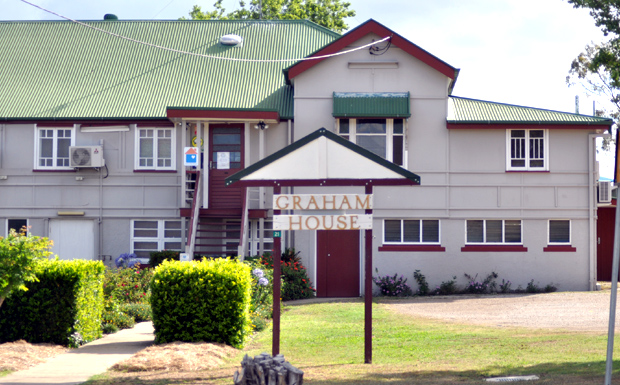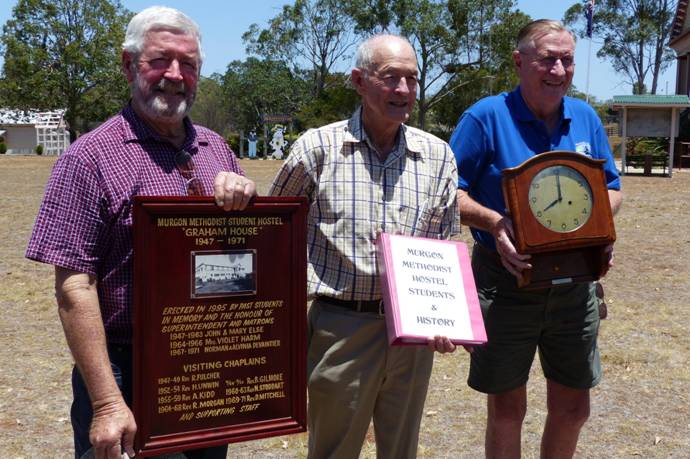
November 30, 2014
by Rod Lonsdale
Murgon Moments
Not many people would know that Murgon’s Graham House was built more than 100 years ago.
These days it houses Graham House Community Centre but over the years the building has also been a private residence, a hospital, a student hostel, a block of flats, and was even used to accommodate workers employed building the Boondooma Dam-Tarong pipeline.
The story of Graham House is one of the key stories of Murgon.
This brief history provides an overview of the many twists and turns this iconic South Burnett building has taken in its century-long journey.
* * *
Graham House, at 21 Taylor St East, was built by stock and station agents Munro and Smith in 1912 for use as the residence of one of the partners (the other partner built his residence at 43 Taylor St East).
In 1922, Nurse Meddleton bought the building and began operating the “Graham Hospital”.
In February 1942, children and staff from Brisbane’s Queen Alexandra Home were evacuated to Graham Hospital. John and Mary Else were Superintendent and Matron.
During 1944, District Inspector of Schools Mr G. Hendren suggested to the Elses that the Methodist Church might consider establishing a student hostel in Murgon.
And after the Alexandra Home children returned to Brisbane in 1945, and with the opening of Murgon High School, the idea of a hostel was raised again.
A considerable amount of interest and discussion followed.
Nurse Meddleton offered Graham Hospital and its grounds to the Methodist Church in a generous arrangement.
This was accepted, and plans and alterations were made to make the building suitable for a student hostel.
Mr and Mrs Else were appointed as Superintendent and Matron from July 1, 1946. The first enrolment ceremony was held on February 1, 1947, with 23 students enrolled. During the first year six casual students stayed for short periods.
* * *

The new hostel provided a convenient and affordable place in Murgon that allowed a lot of students to get a high school education.
If the hostel had not been available, a large percentage of the students’ families would not have been able to afford to send their children to high school.
The student hostel operated from the start of 1947 to the end of 1971, a total of 25 years.
During this time 566 students registered there. Some of these were for short periods, most for at least two years, and Mr E.J. McDonald for 11 years.
In 1952, the hostel was accepted as a War Memorial and this resulted in the erection of a brick War Memorial Fence at the front of the building.
A chiming clock was donated to the Hostel by Mrs Hendren and her daughter in memory of her husband in 1952. This clock is now at the Murgon Dairy Museum.
The last Saturday and Sunday in March were set aside for “Hostel Commem” day. It was celebrated with a Garden Party on the Saturday and a special church service on the Sunday.
In 1962, Mr and Mrs Else received a Rotary Vocational Service Award. At the end of 1963, the couple resigned on medical advice, and Mrs Harm was appointed Matron.
Mrs Harm ran the hostel from September 1964 until she resigned in 1966.
Norman and Alvinia Devantier were appointed to fill her place, and they continued until the closure of the hostel at the end of 1971.
The Hostel’s closure was due to a fall-off in student numbers due to the building of many new high schools, and the introduction of bus services throughout the district.
A complete list of students and a copy of the attendance book compiled by Rod Lonsdale in 2014 is available for viewing at the Murgon Dairy and Heritage Museum.
Past boarders presented the Museum with the Attendance Book and the original clock from Graham House.
Students boarded at the hostel from all over the South and North Burnett and as far afield as Emerald, Maryborough, Linville, Jimbour, Pialba, Theodore, Riversleigh and Port Moresby.
* * *
After its closure as a student hostel, the building and grounds were sold to Hu-Metal, who made the pipe for the Boondooma Dam-Tarong water pipeline. They used it to accommodate their work force.
Following the completion of this contract, the building was again empty for a while until its sale to Mr Cherry, who converted it into flats.
It was then sold to the Department of Children’s Services and Aboriginal Affairs.
A group of local citizens – many of whom were also part of the North Country Deanery of the Catholic Church – were concerned with the lack of services and information available to community members.
The North Country Deanery at that time was applying for funding for the South Burnett Community Development Program to fill this need.
The Department of Children’s Services and Aboriginal Affairs offered the building to the group, which in 1988 became known as Graham House Community Centre. The Centre went on to become an incorporated association in 1992.
Over the next four years Graham House Community Centre accessed small, one-off grants to provide community education, after-school activities and a meeting place for many local groups.
The Spinners and Weavers were one of the first groups to meet regularly in the building, and continue to do so today.
* * *
Graham House Community Centre has experienced huge growth over the past 23 years.
However the mission of the organisation – which is to provide services that respond to the needs of individuals with empathy and dignity, while nurturing the strengths of individuals and the community to empower them to meet their own needs – remains the same.
Graham House services now extend to the whole of the South Burnett area from their location in Murgon.
More details about Graham House can be found on its website























